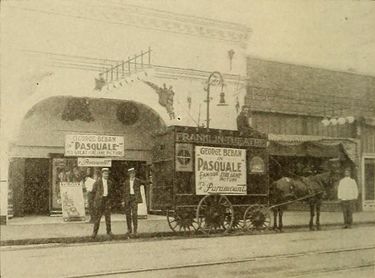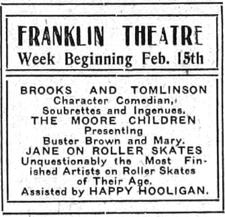Franklin Theatre: Difference between revisions
No edit summary |
No edit summary |
||
| Line 1: | Line 1: | ||
[[Image:1909 Franklin Theatre ad.png|right|thumb| | [[File:1916 Franklin Theater wagon.jpg|right|thumb|375px|1916 photo of the Franklin Theatre]] | ||
The '''Franklin Theatre''' was a Vaudeville theater and [[List of former cinemas|cinema]] located at 1817-1819 [[Avenue E Ensley|Avenue E]] in [[Ensley]]. It and the nearby [[Belle Theatre]] were constructed together in the early 1900s by [[Joe Steed]]. [[Dan McEachern]] managed both houses. Steed experimented in [[1909]] with improved curtains for exhibiting "picture films". | [[Image:1909 Franklin Theatre ad.png|right|thumb|225px|1909 advertisement for the Franklin Theatre]] | ||
The '''Franklin Theatre''' was a 575-seat Vaudeville theater and [[List of former cinemas|cinema]] located at 1817-1819 [[Avenue E Ensley|Avenue E]] in [[Ensley]]. It and the nearby [[Belle Theatre]] were constructed together in the early 1900s by [[Joe Steed]]. [[Dan McEachern]] managed both houses. Steed experimented in [[1909]] with improved curtains for exhibiting "picture films". | |||
Steed reorganized the business to install a motion picture projector in [[1911]]. [[John M. Martin]] was made president of the '''Franklin Theater Company''', which had a capital stock of $3,000. Proceeds from the reopening were donated to the building fund for the [[Ensley Masonic Home]]. | |||
In [[1916]] the Franklin hosted sellout crowds for a series of blockbuster films including "Cabaria", "The Birth of a Nation" and "The Battle Cry of Peace". McEachern built a mule-drawn "cage and pantomime wagon"' on which signs advertising the latest features could be mounted and paraded around the area. The wagon was painted bright red with black and gold trim, and outfitted with small bells to help attract attention. | |||
In [[1917]] the Franklin advertised itself as a "Paramount House", screening features from Paramount, as well as features and shorts from World Brady-Made, K.E.S.E., V.L.S.E., Mutual, Pathé, Artcraft and Selznick. | In [[1917]] the Franklin advertised itself as a "Paramount House", screening features from Paramount, as well as features and shorts from World Brady-Made, K.E.S.E., V.L.S.E., Mutual, Pathé, Artcraft and Selznick. | ||
| Line 8: | Line 13: | ||
During Andrew's tenure daytime films were accompanied by his daughter operating the theater organ, player piano or Victrola. Evening features were accompanied by a big band, often [[J. D. McCorie]]'s ensemble. In [[1926]] the Franklin hosted the world premiere of the feature ''[[Men of Steel]]'', which had been filmed in Ensley. | During Andrew's tenure daytime films were accompanied by his daughter operating the theater organ, player piano or Victrola. Evening features were accompanied by a big band, often [[J. D. McCorie]]'s ensemble. In [[1926]] the Franklin hosted the world premiere of the feature ''[[Men of Steel]]'', which had been filmed in Ensley. | ||
The Franklin closed between [[1930]] and [[1934]]. The building was left vacant and later served twice as a restaurant (a [[Catfish King]] location more recently). | The Franklin closed between [[1930]] and [[1934]]. The building was left vacant and later served twice as a restaurant (a [[Catfish King]] location more recently). The building was later demolished. | ||
==References== | ==References== | ||
Revision as of 11:45, 29 March 2018
The Franklin Theatre was a 575-seat Vaudeville theater and cinema located at 1817-1819 Avenue E in Ensley. It and the nearby Belle Theatre were constructed together in the early 1900s by Joe Steed. Dan McEachern managed both houses. Steed experimented in 1909 with improved curtains for exhibiting "picture films".
Steed reorganized the business to install a motion picture projector in 1911. John M. Martin was made president of the Franklin Theater Company, which had a capital stock of $3,000. Proceeds from the reopening were donated to the building fund for the Ensley Masonic Home.
In 1916 the Franklin hosted sellout crowds for a series of blockbuster films including "Cabaria", "The Birth of a Nation" and "The Battle Cry of Peace". McEachern built a mule-drawn "cage and pantomime wagon"' on which signs advertising the latest features could be mounted and paraded around the area. The wagon was painted bright red with black and gold trim, and outfitted with small bells to help attract attention.
In 1917 the Franklin advertised itself as a "Paramount House", screening features from Paramount, as well as features and shorts from World Brady-Made, K.E.S.E., V.L.S.E., Mutual, Pathé, Artcraft and Selznick.
In the early 1920s, McEachern was recruited to the Tennessee Coal, Iron & Railroad Company as a safety engineer. Management was then turned over to Joseph Andrews.
During Andrew's tenure daytime films were accompanied by his daughter operating the theater organ, player piano or Victrola. Evening features were accompanied by a big band, often J. D. McCorie's ensemble. In 1926 the Franklin hosted the world premiere of the feature Men of Steel, which had been filmed in Ensley.
The Franklin closed between 1930 and 1934. The building was left vacant and later served twice as a restaurant (a Catfish King location more recently). The building was later demolished.
References
- Prince, A. G. (1982) Landmarks of Ensley: Past and Present. revised edition. Ensley: Best Printing Service

